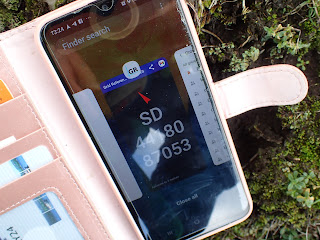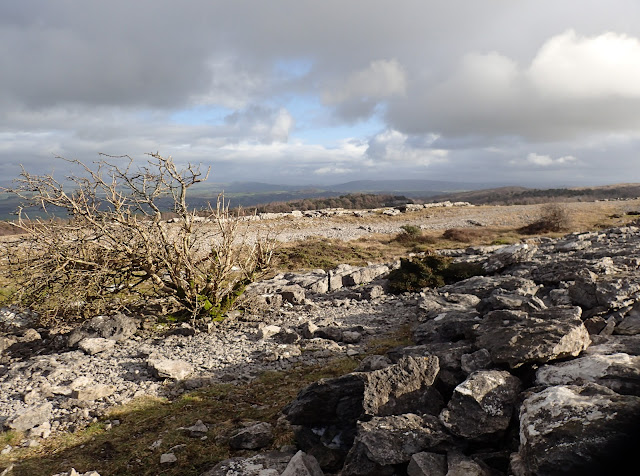The Cumbria Lichens and Bryophytes group had planned a Meeting at Whitbarrow. a Cumbria Wildlife Trust Reserve, at the SE end of the Lake District the limestone cliffs look down on the A590
Having driven past this scar several times along the main road running along the south of the Lake district- A590, and knowing it is a Nature Reserve I wanted to go and see it.
The forecast said misty but turning into brighter spells.
It is c 33 miles from where I live.. and it turned out it took me just over 50 minutes to drive there. Not bad!
We were a big group - someone said 22 in total.
We split into two groups.. The Mosses people shot off, through the field, through the wood, up the steep wooded slope along the exposed limestone pavement and scree areas towards the summit.. The lichens people stopped after walking 200 m through grass to the first hawthorn tree and spent the first hour (till 10.51) looking a lichens on these couple of hawthorn trees and on a c2m wide, 40cm tall limestone ledge/outcrop in an otherwise agriculturally improved field. Pete Martin introduced the Newbies in the group to lichen structure and they examined the different lichens on these trees.
The lichens both on the tree and on the ledge were dark and swollen, full of water from the abundant rain on many previous days, and maybe from mist earlier this morning.. The mist had gone by now. This made the lichens hard to recognise.. Maybe we had some Hyperphyscia adglutinata - Minutely tiny green foliose lichen with sparkling gold bits.
On the limestone ledge SD43818607 were big pale green blobs of Nostoc (useful for explaining about blue green algae and the 2 billion years of the earth's life, when Blue green algae/bacteria were the only living things.
Caz found some Petractis clausa lower down on this vertical surface, much of the apothecia grazed by snail,
 |
| Petractis clausa 1.3cm wide view |
 |
| Scoliciosporum candicans I think looking very green as saturated with water |
 |
Aspicilia contorta looking very green as saturated with water
|
There were several species of lichen with blue green algae: Collema auriforme, Leptogium ...
 |
Collema?
I need to check this. |
Next stop after another 300m was the wood. We are now in SD439862 . There was lots of Graphis scripta on the hazel. Chris spotted some "Red Wine gums" - Pachyphiale carneola
This is supposed to be rare.. but it is the third trip Chris has found it and showed it to me. I then found my own thallus. Satisfying.

 |
| Scarlet Elf cups growing surrounded by Thuidium tamariscinum |
 |
| I think this is Hypotrachyna afro-rovoluta? growing on a fallen branch - though maybe not happe. |
 |
| Leptogium |
Another hour soon went by in the woodland at the foot of the slope.
I wondered whether the lichens would ever go up to the pavement. So I set off up the slope - and up and up
 |
| Not sure what this black stuff is on this fallen tree - maybe a fungus |
here was a footpath along the sloping plateau - well plateau but still gong up at the top.. And I could see the bryologists in the distance. I climbed up to them. they had just finished lunch. they were just setting off. Typical.
 |
| There must have been a reason for this photo. |
 |
| I was in a monad north of the others and found this Riccia on a grassy ant hillock |
 |
| I was in a monad north of the others and found this Riccia on a grassy ant hillock |
 |
| A Peltigera near the "Tarn" |
 |
| View south from the summit. |
 |
| Rusty-back Fern at the kissing-gate entrance/exit to our walk. |


































































